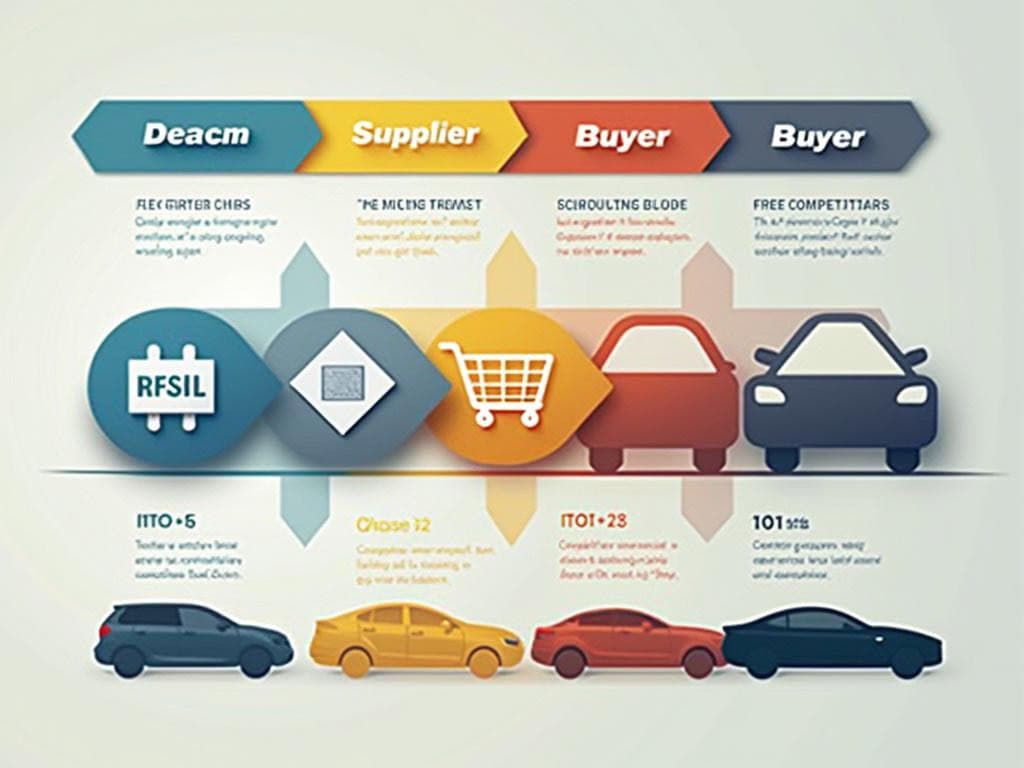
Understanding Porter’s Five Model Examples
Porter’s Five Model examples show how competitive forces shape industries through four key dynamics: new entrant threats in streaming services, supplier power in semiconductors, buyer leverage in retail, and competitive rivalry in automotive sectors. These applications demonstrate how this framework provides a structured approach to analyzing market dynamics, competitive positioning, and the forces that determine industry profitability and strategic opportunities.
Strategic Importance for Business Decision-Makers
Porter’s Five Model examples give crucial insights for corporate strategists trying to compete effectively and develop sustainable advantages. You’ll gain valuable perspective on how supplier bargaining power limits semiconductor manufacturers or how consumer price comparison tools transform retail strategies. This analytical tool helps you anticipate competitive threats, spot industry changes, and make smart strategic decisions that address the specific competitive forces affecting your market position.
The examples from Porter’s original Harvard Business Review article continue to provide relevant guidance for modern business challenges. By examining these real-world applications, you’ll better understand how to apply this framework to your specific industry situation.
When analyzing supplier power in the semiconductor industry, you’ll notice how limited supplier options and specialized components create leverage points that impact pricing strategies. Similarly, in retail sectors, buyer power examples highlight how informed consumers with multiple purchasing options force companies to adapt their value propositions.
Porter’s five model examples aren’t just theoretical—they’re practical tools that help you assess your competitive landscape and develop appropriate responses. By breaking down complex market dynamics into these structured components, you can identify which competitive forces require your immediate attention and which present opportunities for strategic advantage.
Effective Porter’s Five Model Examples: Explore 4 Key Industry Insights Now
In this section, we delve into four compelling examples of Porter’s Five Forces model across various industries, illustrating how these forces shape competitive dynamics and influence strategic planning. Each example highlights a distinct force—from the threat of new entrants in the streaming services sector to the bargaining power of suppliers in the semiconductor industry, buyer power in retail, and competitive rivalry in the automotive market. By examining these key insights, you will gain a better understanding of how businesses can navigate industry challenges, adapt to market demands, and innovate for sustained growth. Explore each example to see how different sectors respond to these competitive pressures and optimize their strategies in today’s fast-paced market environment.
1. Streaming Services Industry: Threat of New Entrants
When analyzing Porter’s five model examples in the streaming industry, the threat of new entrants represents a significant force. Although substantial barriers to entry exist, including high content production costs that can reach hundreds of millions for original programming, determined competitors continue to emerge. Major corporations with deep pockets can overcome these obstacles, as demonstrated when Disney+ leveraged Porter’s model to enter Netflix’s territory in 2019.
Network effects create additional hurdles for new entrants. Established platforms benefit from larger user bases that attract more content creators, making it challenging for newcomers to gain traction. However, companies with existing media libraries and brand recognition can disrupt the market more easily.
The impact of these new entrants manifests in several ways:
- Price competition intensifies as services compete for subscriber dollars
- Content wars escalate with increased investment in exclusive programming
- Bundling strategies emerge to improve value propositions
- Market consolidation occurs as smaller players struggle to compete
This competitive landscape requires streaming services to continuously refine their strategic planning approaches to maintain their market positions.
2. Semiconductor Industry: Bargaining Power of Suppliers
In the semiconductor industry, Porter’s five model examples clearly illustrate the significant bargaining power suppliers hold. The industry faces unique supply chain challenges due to a limited number of specialized manufacturers capable of producing advanced chips. Companies like TSMC (Taiwan Semiconductor Manufacturing Company) demonstrate this power through their dominance in chip manufacturing, controlling approximately 54% of the global foundry market.
When analyzing Porter’s five forces in this sector, you’ll notice the high switching costs between suppliers create significant dependencies. Changing from one chip supplier to another requires:
- Extensive product redesigns
- Compatibility testing cycles
- Production line adjustments
- New quality assurance protocols
These factors make it extremely difficult for computer and smartphone producers to negotiate favorable terms. Apple’s relationship with TSMC demonstrates this dynamic, as the tech giant relies heavily on TSMC’s advanced manufacturing capabilities for its custom-designed chips.
The Porter’s five forces analysis of this industry shows how this bargaining power impacts strategic planning across the technology sector. When chip shortages occur, as witnessed during 2020-2022, suppliers can prioritize certain customers and adjust pricing with limited pushback from buyers who have few alternatives.
Expert Insight: In the semiconductor industry, suppliers wield significant bargaining power due to limited alternatives and high switching costs. Companies must strategically manage relationships with dominant suppliers like TSMC to mitigate risks associated with supply chain disruptions. Building collaborative partnerships can enhance negotiation leverage and ensure more favorable terms during chip shortages.
3. Retail Industry: Bargaining Power of Buyers
The retail sector provides classic Porter’s five model examples of buyer power significantly influencing market dynamics. Today’s consumers wield unprecedented leverage through digital tools that enable instant price comparisons across multiple platforms. This fundamental shift has transformed how retailers must approach their pricing strategies.
When analyzing Porter’s five model examples in retail, the low switching costs become particularly evident. Shoppers can easily abandon one retailer for another with minimal inconvenience, creating intense pressure on businesses to maintain competitive pricing and service quality. Consider these manifestations of buyer power:
- Price comparison websites and apps enabling instant price checks
- Customer review platforms influencing purchasing decisions
- Mobile shopping allowing immediate competitor research
- Loyalty programs attempting to reduce switching behavior
Amazon exemplifies a strategic response to high buyer power within Porter’s five model examples. Their customer-centric approach, featuring fast shipping, easy returns, and competitive pricing, acknowledges that Porter’s competitive analysis requires adapting to buyer demands. Other retailers have followed suit by improving their omnichannel experiences and personalization efforts.
This increasing buyer power continues reshaping retail pricing models, profit margins, and service innovations as the industry evolves.
Expert Insight: To thrive in the retail industry, understand that buyer power has intensified due to digital tools enabling price comparisons and easy switching. Prioritize competitive pricing, exceptional service, and personalized experiences to retain customers. Embrace technology to enhance omnichannel strategies and address evolving consumer expectations effectively.
4. Automotive Industry: Competitive Rivalry
The automotive sector provides one of the most instructive Porter’s five model examples when examining competitive rivalry. Traditional car manufacturers face intense pressure to maintain market share while managing high fixed costs that drive production volume targets. You’ll notice how established players like Ford, Toyota, and GM continuously adjust their strategies to remain competitive.
Tesla’s market disruption exemplifies the dynamic nature of this industry force within Porter’s five forces framework. By introducing electric vehicles with innovative features, Tesla forced traditional manufacturers to accelerate their EV development programs or risk losing relevance. This competitive pressure has directly impacted strategic planning initiatives across the entire industry.
The resulting effects include:
- Accelerated innovation in autonomous driving technology
- Price wars in specific vehicle segments
- Strategic mergers and acquisitions to share development costs
- Increased focus on differentiation through brand identity
For automotive executives, understanding competitive rivalry through Porter’s model helps identify strategic opportunities while preparing for risk response strategies in this rapidly evolving industry landscape.
Expert Insight: To navigate competitive rivalry in the automotive industry, executives must leverage insights from Porter’s model to identify strategic opportunities. Emphasizing innovation and differentiation is crucial, especially in response to disruptors like Tesla. Proactive risk management strategies will help maintain market relevance in this fast-evolving landscape.
Porter’s Five Forces Model Examples
Porter’s five forces model examples illustrate how competitive forces—threat of new entrants in streaming, supplier power in semiconductors, buyer power in retail, and competitive rivalry in automotive—shape industry dynamics and strategic decisions. These forces demonstrate how market participants navigate complex competitive landscapes through strategic responses such as content differentiation, supplier relationship management, customer-centric approaches, and innovation investments.
Importance of Porter’s Five Forces
Porter’s five model examples provide essential analytical frameworks for business leaders to evaluate competitive pressures and develop effective strategic responses. By examining how these forces manifest across industries—from streaming services facing new entrants to semiconductor manufacturers navigating supplier power, retailers responding to empowered consumers, and automakers battling intense rivalry—organizations can identify potential threats, uncover growth opportunities, and craft sustainable competitive advantages that drive long-term business success.






